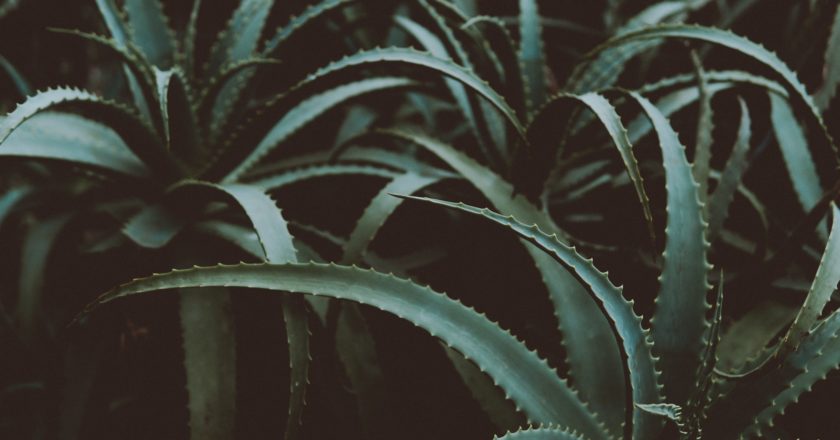Aloe Vera is also known as medicinal aloe, “lily of the desert” or “elephant’s gall” and it belongs to the family of succulent plants in the genus ‘Aloe’. Its origin is believed to be in Sudan and has been used for more than 6,000 years, being recognized by many civilizations including the Egyptians, Spanish, Persians, Greeks, Italians, Africans, Japanese, and Indians. It grows best in warm and dry climates and that is why it is densely found in those areas, but it can be easily grown both indoors and outdoors.
Aloe Vera plant is often a stemless or sometimes very short-stemmed juicy plant that grows around 60–100 cm in height and the offsets spread out wide. The leaves of this plant are thick and fleshy and the color varies from green to gray-green. Some varieties of this plant have white flecks on the upper and lower portions of the stem surfaces. The margin of the leaves is like saw-tooth and the flowers bloom during the summer. Each leaf is full of a slimy tissue that stores water, which makes the leaves thick.
This slimy, water-filled tissue is the “gel” we usually associate with Aloe Vera products, and it contains most of the bioactive compounds in the plant, including vitamins, minerals, amino acids and antioxidants. This plant has also compounds such as mannans, polysaccharides, lectins, and anthraquinones that are extremely beneficial for human health. Let’s have a look at all the benefits of this amazing plant:
- For skin care (wounds, sores, rashes, etc.)
The pure inner gel extracted from the Aloe leaf is the best natural remedy for skin abrasions and it also helps diminish the symptoms of aging skin conditions like wrinkles. Many skin care and personal care products, toiletries, and cosmetics include Aloe extracts. In fact, if you have its plant at home, simply tear a small part of the leaf, take the gel and apply it in the raw form on your face. The topical external use of this plant is the most commonly known and it has long been known as a treatment for sores, particularly burns, including sunburns. Some people prefer drinking its juice, which also enhances skin health, as the properties of the plant work internally. It also helps in curing stings, rashes, acne, and psoriasis.
- For beauty (moisturizer, hair care, teeth care etc.)
Aloe Vera has proven to be an excellent option for promoting naturally hair growth and essential to retain voluminous and healthy hair. You can apply its gel to the entire scalp or use a shampoo, which stimultaing your scalp can improves blood circulation and keeps you away from stress and mental tiredness.
Dental and gum diseases can also be cured by Aloe Vera. You can try out this natural remedy at home: put some of its powder on your toothbrush, then brush normally. It will soothe your gums and cure any kind of infection or bruises.
- For digestion
The adaptogenic properties of Aloe Vera are beneficial for a proper digestion. It ensures better nutrient absorption and also eliminates harmful elements through smooth excretion. Its compounds called polysaccharides have the ability to cure a host of digestive disorders and ulcers, which are one of the most prominent consequences of digestive problems. Many studies have proven that with its anti-inflamamtory qualities it improves issues like Crohn’s disease, peptic ulcers, and other digestive tract disorders, mainly driven by the inflammation of digestive organs.
- For constipation
This time it is not the gel, but the latex, that provides the benefits. The latex is a sticky yellow residue found just under the skin of the leaf and the key compound responsible for this effect is called aloin, or barbaloin, which has well-established laxative and diuretic effects (however, some concerns have been raised about safety issues with frequent use).
- For immunity
Aloe Vera gel, again, contains powerful antioxidants, which belong to a large family of substances known as polyphenols. These polyphenols, along with several other compounds in Aloe vera, can help inhibit the growth of certain bacteria that can cause infections in humans. Beverages made with aloe vera juice possess natural detoxifying properties that effectively cleanse the digestive system and the circulatory system. As the absorption level of nutrients accelerates, it results in better blood circulation and also improves health. Infact, when the blood is oxygen-rich, it automatically provides nutrients within the cells more proficiently. Zinc is also an important component in this fantastic plant and it’s essential to maintain a proper immune function.
- For diabetes and general regulation of blood sugar
Some evidence in humans and animals suggested that Aloe Vera is able to alleviate the chronic hyperglycemia (high blood sugar level) and perturbed lipid (fat) profile that are common among people with diabetes and are major risk factors for cardiovascular complications.
- For pain
The extract of Aloe Vera has shown to be an excellent stimulant of the uterus and intake of its juice is very beneficial during painful menstruation.
The anti-inflammatory properties of Aloe Vera help it to work efficiently on joints and muscle pains, caused by heavy physical acivity or diseases like gout or arthritis. Applying Aloe gel topically eases inflammation and swelling of the joints.
Aloe Vera Smoothie Recipe:
Ingredients
- 1-2 cups of coconut water
- 1 tablespoon of coconut oil
- lemon, if you like it
- 1 cup of fresh mango (or any other fruit you like!)
- 1 fresh banana (or any other fruit again!)
- a handful of fresh mint
- 1 medium Aloe Vera leaf filletted (1/2 cups)
How to fillet an Aloe Vera leaf:
- First, cut off any white parts close to the root of the leaf.
- Then trim the prickly sides by slicing them off entirely using a paring knife. When doing so, try to take off as little as possible.
- With the convex side facing up, use a potato peeler to remove the skin from the leaf. Alternatively, you can slice off the top skin with the knife.
- Then, slide the knife under the gel to separate it from the leaf skin, making sure there is no leftover skin on the gel.
- Dice the gel into smaller pieces. Refrigerate and cover your leftover Aloe.
- Add straight into your blender or juicer with the rest of the ingredients.
- Enjoy!

